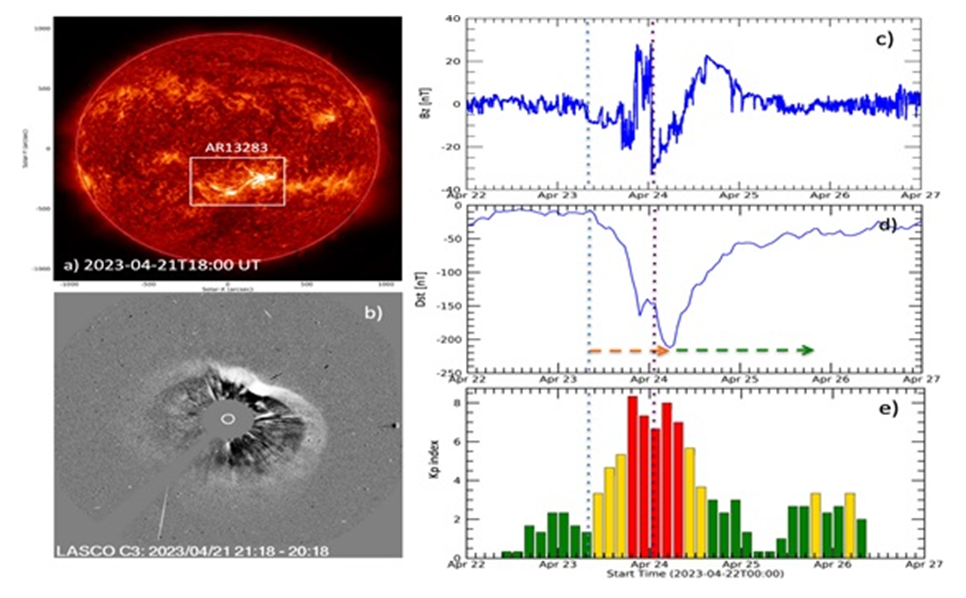Ministry of Science & Technology
Tracking the solar source of the most intense geomagnetic storm last year
प्रविष्टि तिथि:
01 MAR 2024 3:40PM by PIB Delhi
In late-April 2023, a severe geomagnetic storm in Earth’s magnetosphere led to an vivid display of the aurora in in lower latitudes extending to places like Ladakh. Astronomers have used multiwavelength observations from multiple space telescopes to track the origins of the storm in the Sun. They found that the rotation of the filament structure when it was near the Sun was the leading cause behind this solar storm which resulted in such a strong effect on the Earth.
The sun often ejects ionized gas, (plasma) and magnetic fields in the form of coronal mass ejections (CMEs) into inter-planetary space. When these CMEs encounter planets such as our Earth, they interact with the planetary magnetic fields resulting in major magnetic storms. Accelerated particles and geomagnetic storms can adversely affect human technology on Earth and in space. Thus, understanding and predicting CMEs has both scientific and practical importance.
A large-scale CME eruption originated from the ‘Active Region 13283’ located near the solar disk center at midnight (IST) on April 21, 2023, resulting in the most intense geomagnetic storm of solar cycle 25. The CME was launched at a speed of about 1500 km/s and encountered the near-Earth environment on April 23 at 12:30 PM IST. Consequently, a geomagnetic storm commenced an hour later at the Earth. The storm reached its peak value of magnetic field and was classified as “G4 severe”. The resultant auroral light were captured by all sky cameras located at the Indian Astronomical Observatory in Hanle, Ladakh, which is operated by the Indian Institute of Astrophysics.
The data collected helped track the source of the storm in the Sun in research by Indian Institute of Astrophysics, an autonomous institute under Department of Science and Technology published in The Astrophysical Journal.
“Surprisingly, since the CME was launched from a weak magnetic field region on the Sun, such intense geomagnetic storms are unexpected. This is because the energization process is expected to be slower, and the formation of twisted magnetic flux is also unlikely” said Dr. P. Vemareddy, the author of the study. CME is associated with a pre-existing magnetized plasma filament in the source active region on the Sun. The magnetic fields evolve with the changing sign of its helicity a few hours before the eruption, which could be the prime destabilizing factor of the magnetic field equilibrium in the solar atmosphere.
For a CME to be geoeffective, the magnetic fields have to be directed southward with respect to the earth’s magnetic field. Importantly, during this eruption from the sun, the CME structure rotated by about 56 degrees in a clockwise direction. This rotation is caused by magnetic forces, and very few CME structures are seen to exhibit such evolution. Due to this rotation, the CME magnetic fields became oriented dominantly southward and the CME’s further propagation in the heliosphere led to the conditions for effective interaction of CME magnetic fields with the earth. This was what caused the most intense storm of solar cycle 25.
This study indicates the importance of having a complete picture of CMEs, including their magnetic structure and the mechanisms involved in their origin from the solar source regions, their evolution, and their propagation from the Sun to the Earth. In addition to the other space-based telescopes, the researchers are looking forward to using the observations of the sun provided by the recently launched space observatory Aditya-L1. The instruments onboard this satellite provide both remote and in situ observations enabling us to understand the CME launch at the sun as well as its arrival at the near-Earth space. “In particular, imaging observations close to the Sun are crucial to determine the orientation and speed of the CME which the space payload Visible Emission Line Coronagraph (VELC), developed by the Indian Institute of Astrophysics, is going to provide soon ”, opined Dr. P. Vemareddy.
Publication: Filament Eruption from Active Region 13283 Leading to a Fast Halo-CME and an
Intense Geomagnetic Storm on 2023 April 23
Doi: https://doi.org/10.3847/1538-4357/ad1662

Figure caption: The CME eruption from the Sun occurred on 2023 April 21, at 18:00 UT. a) The image of the sun at 30.4 nanometres wavelength showing the location of the active region AR13283 (from AIA onboard NASA’s SDO spacecraft). b) An image processed to enhance the bright leading edge and core of the CME (from LASCO/C3 on SOHO spacecraft). c) In situ observations of vertical magnetic field observed by NASA’s WIND spacecraft, d) Disturbance storm index showing the earth’s magnetic field during the storm, and e) the Kp index as a function of time.
***
SNC/PK
(रिलीज़ आईडी: 2010590)
आगंतुक पटल : 2297